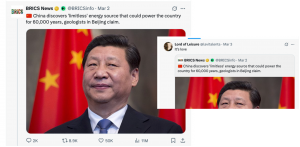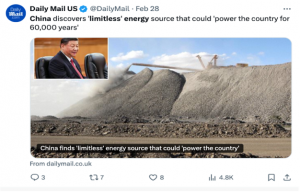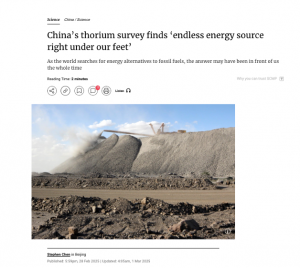We’ve noticed this claim circulating across social media and local chat groups alongside heated discussion. According to the claim, China has uncovered limitless energy with which to power itself for 60,000 years. The most viewed post has garnered over 11 million impressions on X, with a wide spectrum of reactions – from jokes to panic – on display. Some reactions express fear of China, while others seem to suggest that claims made by China are inherently untrue. With the backdrop of the ongoing global race to expand nuclear technologies and significant deals being signed (such as between the US and Ukraine), claims such as this one need to be scrutinised closer to fully understand the facts.
Some reactions express fear of China, while others seem to suggest that claims made by China are inherently untrue. With the backdrop of the ongoing global race to expand nuclear technologies and significant deals being signed (such as between the US and Ukraine), claims such as this one need to be scrutinised closer to fully understand the facts.
According to our research, the energy source being referred to (although rarely specified) in these claims is thorium, a naturally occurring element that may be a possible source of safer and cleaner nuclear energy. When processed, thorium can be transformed into an atom of uranium-232, which then undergoes fission to produce nuclear energy. Given the abundance of thorium (it is more abundant than uranium), it has been mooted by some advocates as the future of abundant nuclear energy. However, thorium-based nuclear energy is still in the research and development stage, with no full-scale or commercial reactors in use.
This particular claim (specifically its phrasing and framing) is derived from a Daily Mail article published several days ago which references a South China Morning Post report as its main source. The article does detail further information about thorium despite the fact that claims circulating on social media seem to have merely picked up and run with its headline. According to the SCMP article, a declassified report on a national survey (completed in 2020) of China’s thorium reserves has shown that these reserves might far exceed previous estimates – with one specific mining complex potentially yielding 1 million tonnes of thorium, which some scientists estimate can fuel China for 60,000 years.
According to the SCMP article, a declassified report on a national survey (completed in 2020) of China’s thorium reserves has shown that these reserves might far exceed previous estimates – with one specific mining complex potentially yielding 1 million tonnes of thorium, which some scientists estimate can fuel China for 60,000 years.
This added context itself already serves to make the claim headlines rather less startling.
For one, it lessens the newness suggested by the claim. Rather than just discovering “limitless” energy, China has been researching and intentionally exploring its thorium resources for some time. An earlier SCMP article, for instance, covered China’s earlier estimation that thorium could power it for 20,000 years.
Secondly, the claims might suggest to causal readers that the energy source is itself a new or ground-breaking discovery, thorium has been researched and identified as early as 1940, with experimental projects run by different countries since then. In 2025, China is slated to pull ahead with its development of thorium-specific nuclear energy – having announced that imminent construction of a large-scale reactor in the Gobi Desert with the goal of becoming commercially operational by 2030.
However, while the focus on China might therefore be warranted, significant reserves of thorium can also be found in other countries – such as India, Brazil, Australia, and the United States. Countries such as India and Denmark also have ongoing thorium-specific research projects. This context is missing from the claims, which might mislead readers into believing that thorium is something only China has. Therefore, while the headlines circulating technically stem from a real report, the specific details recently published by SCMP have not been confirmed by China – and those details have been condensed into headlines and claims that are misleading and could cause the spread of misinformation.
Therefore, while the headlines circulating technically stem from a real report, the specific details recently published by SCMP have not been confirmed by China – and those details have been condensed into headlines and claims that are misleading and could cause the spread of misinformation.
We give this claim a rating of possibly true – if thorium proves to be a viable source for nuclear energy, China’s thorium resources have the potential to supply it with a great deal of energy. However, this is neither a recent nor earth-shattering discovery as the claim’s framing suggests.

We also looked at more local reactions in Singapore-based forums and chat groups where users some expressed excitement, while others speculated about a connection with the recent nuclear direction discussed in Singapore’s Budget 2025 – where Prime Minister Lawrence Wong announced the government’s interest in studying the “potential deployment of nuclear energy in Singapore.”
As Singapore and Singaporeans continue to have a vested interest in the development of new, clean energy sources (particularly with our 2050 goal of net-zero planet warming emissions), it is becoming increasingly important to have a clearer understanding of what nuclear energy is – and where the technology is at. The term “nuclear” remains one that can cause confusion or even fear and suspicious, leading to a lack of general knowledge about its potential as an energy source.
While this claim is perhaps relatively easily cleared up and contextualised, future claims about nuclear technologies are something to keep a critical and sceptical eye on to prevent the spread of mis/disinformation.



